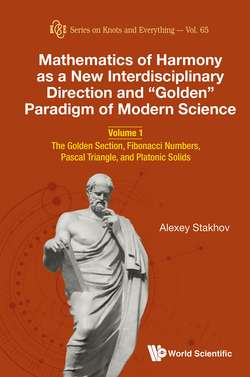Читать книгу Mathematics of Harmony as a New Interdisciplinary Direction and “Golden” Paradigm of Modern Science - Alexey Stakhov - Страница 23
На сайте Литреса книга снята с продажи.
1.1.5. Once again about the term of the Mathematics of Harmony
ОглавлениеAs mentioned in the preface, for the first time, the term Mathematics of Harmony was introduced in a short article “Harmony of spheres”, published in The Oxford Dictionary of Philosophy [103]. This doctrine, often attributed to Pythagoras, leads to the unification of mathematics, music, and astronomy. Its essence is the fact that the celestial solids, being huge objects, must produce music during their movement. The perfection of the heavenly world requires that this music must be harmonious; it is hidden from our ears only because it is always present. The Mathematics of Harmony was a Central Discovery of Immense Importance for the Pythagoreans.
Thus, the concept of the Mathematics of Harmony in [103] is associated with the “Harmony of spheres”, which was also called the Harmony of the World or world music. The “Harmony of spheres” is an ancient and medieval doctrine about the musical and mathematical structure of the Cosmos, which goes back to the Pythagoras and Plato philosophical tradition.
Another mention about the Mathematics of Harmony, applied to ancient Greek mathematics, is found in the book by Vladimir Dimitrov A New Kind of Social Science. The Study of Self-Organization of Human Dynamics, published in 2005 [54]. Here is a quote from this book:
“The prerequisite for Harmony for the Greeks was expressed with the phrase “nothing superfluous.” This phrase contained mysterious positive qualities, which became the object of the study of the best minds. Thinkers, such as Pythagoras, sought to unravel the mystery of Harmony as something unspeakable and illuminated by mathematics.”
The Mathematics of Harmony, studied by the ancient Greeks, is still an inspiring model for modern scholars. Of decisive importance for this was the discovery of the quantitative expression Harmony, in all the amazing variety and complexity of Nature, through the golden section Φ = (1 + )/2 that is approximately equal to 1.618. The golden section is described by Euclid in his Elements: “It is said that a straight line can be divided in extreme and mean ratio, when, the entire line so refers to the most part, like most to lesser.”
It is important to emphasize one more aspect in the book [54] — the concept of Mathematics of Harmony is directly associated with the golden section, the most important mathematical discovery of the ancient science in the field of the Mathematical Harmony, which at that time was called the “division of a segment in the extreme and mean ratio.”
